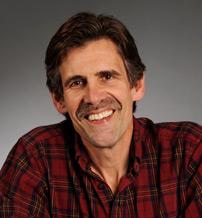
BEI Emeritus fellow Tom Montgomery Fate was originally featured as a guest author in The Daily Herald.
Looking for truths, comfort in ‘the gospel of this moment’
I retired from the classroom two months before the pandemic hit. Just in time to avoid the overnight shift to teaching online but not the sense of being trapped in the present tense. It’s still hard to plan beyond the weekend. Teachers and students remain unsure if they’ll return to the classroom in the fall. And the sad hum of anxiety drones beneath everything.
President Trump’s sloganeering reflects this spiraling uncertainty about the future. His recent shift from “Keep America Great,” to the new “Transition to Greatness” reveals that we are stuck in the chaotic present. The transition is a bridge to somewhere, but no one knows where. No one remembers anymore what “normal” is. Or what hour, or what day of the week, or month.
Today, while sorting through a box of old teaching materials, I came across a manila folder titled The Present Tense. In it were notes about the naturalist Henry David Thoreau, whose work I often teach. For Thoreau, the present tense was not a cage but a gift. “The gospel of this moment” he called it. “You must live in the present,” he writes in Walden.
During the pandemic, some have suggested that being less harried and more present to our partners and children—-our fellow inmates—-may be the silver lining. We now may have longer dinner conversations or perhaps play board games. Others may focus their new timeless presence on cooking or home repair. However, in our family (like many, I assume), there is also the constant lure of video games and social media, and all those screens we were already addicted to.
That was a problem Thoreau didn’t encounter. In the mid 19th century he didn’t even have screens on his windows. But his concern with being fully present is not the only part of his life still relevant now, amid the pandemic. He is the most well-known social distancer in American literature, and also lived during an epidemic — Tuberculosis — from which he died at 44, in 1862. There was no real “medicine” then, only the sanatorium and death.
As his magnum opus, Walden, confirms, Thoreau also had “cabin fever,” but it was different from ours, in that he chose it, and it inspired rather than mired. He sought solitude and so self-quarantined for two years in a 10-by-15 foot shanty that he built himself on Walden Pond (near Concord, Massachusetts), as an experiment in “deliberate” life.
During Thoreau’s era, “cabin fever” often referred to homesteaders in Nebraska or Iowa who lived literally “off the beaten path,” and could be snowed in their cabins for months. Isolated from community and commerce, the long wait for the spring thaw tested their sanity.
Our cabin fever today — our physical and emotional isolation — is not caused by weather and roadlessness but a new virus. Unlike the 19th century, we now DO have medicine, and vaccines, and so didn’t expect a plague to infect millions. Which is why, after months of confinement, many were asking, “Could this get any worse?”
The answer is: Yes. As I write, a second plague is sweeping the U.S. and undoing our ability to heal: racism, reignited by the heinous murder of a black man, by a white police officer in Minneapolis. Torture is the best word to describe the death of George Floyd, as he was suffocated by Derek Chauvin, who had his knee on Floyd’s neck.
“I cannot … recognize that political organization as my government which is the slave’s government also,” he wrote.
He hid escaped slaves in his cabin, accompanied them to the railway station and put them on a train for Canada. Part of his cabin fever was for justice. His reflection and contemplation eventually led to action. This suggests why Martin Luther King cited “Civil Disobedience” as an inspiration for the nonviolent strategy he developed in the civil rights movement of the ’50s and ’60s.
We are all living in a dangerous and fragile moment in history. But like Thoreau, we all have a conscience and the ability to both reflect and act, to think long-term and short, to create and destroy, to listen and talk, to be present and absent. The question is what will we choose, and if American democracy will survive those choices.

